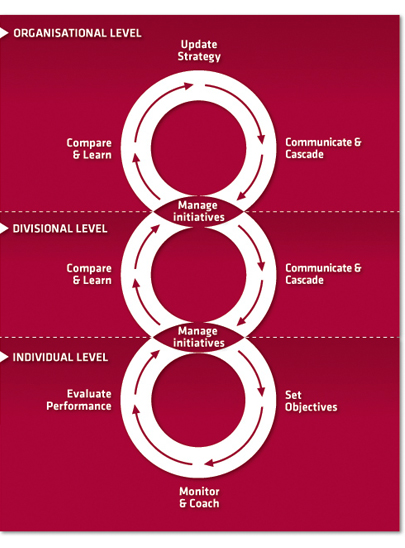Cascade strategy I Use The 8 – a strategy execution model – to cascade your business strategy!
Cascade strategy I Use The 8 – a strategy execution model – to cascade your business strategy!
“Cascade strategy” is a crucial step in the strategy execution process. Cascade your strategy successfully and you execute business strategy much better.
Let’s take a closer look at cascade strategy: (1) where it fits into the strategy execution process and (2) definition and meaning of cascading strategy
How does “cascade strategy” fit into the strategy execution framework?
Cascading strategy is the process step that comes after strategy communication in The 8, a easy-to-use strategy execution model. Want to know more? Watch this video about the strategy execution model.

When you cascade your company’s strategy, you break down the company goals into smaller chunks for the next organizational level. The process stops at the smallest unit level – often teams. In the end, the size of your organization will define the size of the cascade. If you work in a large organization, your strategy cascade will happen several times

Cascade strategy definition and meaning
It is crucial to achieve macro alignment between all the goals – horizontally and vertically – in your organization. You can achieve better alignment by aiming for MECE – Mutually Exclusive and Collectively Exhaustive. This simply means that everything from the level below (business strategy, initiatives, objectives, etc.) should add up exactly to the level above, without any overlaps. This may sound logical and easy, but practice shows that many companies have a difficult time linking levels correctly.
One of the reasons companies find it hard to get the macro alignment right is the complex matrix of responsibilities. Strategy execution accountabilities are often blurred and spread across an organisation.
When you look at the strategic cascade of an organization, you can have up to 10 different parties involved, including corporate functions, functional lines, regional structures and countries. In addition, within each of these structures, responsibilities are often dispersed among human resources, finance, the strategy department and the various leadership teams.
When your macro alignment doesn’t seem to be working, start by taking a look at the complexity of the Strategy Execution accountabilities and reduce where possible.
On a micro level, you need to balance your objectives across perspectives. The four traditional perspectives are: financial, customer, internal processes and people. But you can always add other dimensions as appropriate. The Balanced Scorecard is the best-known method. I have written an extensive guide on the Balanced Scorecard if you like to know more about this strategy cascade technique.

In addition to the balancing act on the macro and micro levels, you need to select the right indicators – often called Key Performance Indicators or KPIs – to track the objectives and define appropriate targets. Often organizations use strategy execution software to monitor strategy progress and see if they execute strategy successfully.
Want to learn more about strategy execution and the different steps in the strategy execution process? Check out this Balanced Scorecard Guide or the ultimate strategy execution tutorial:
